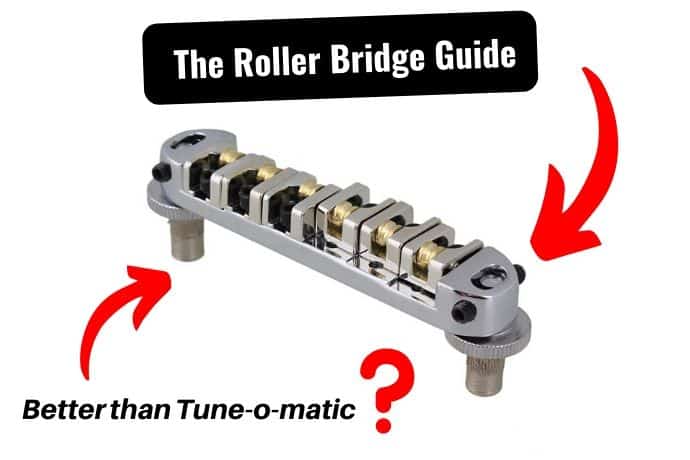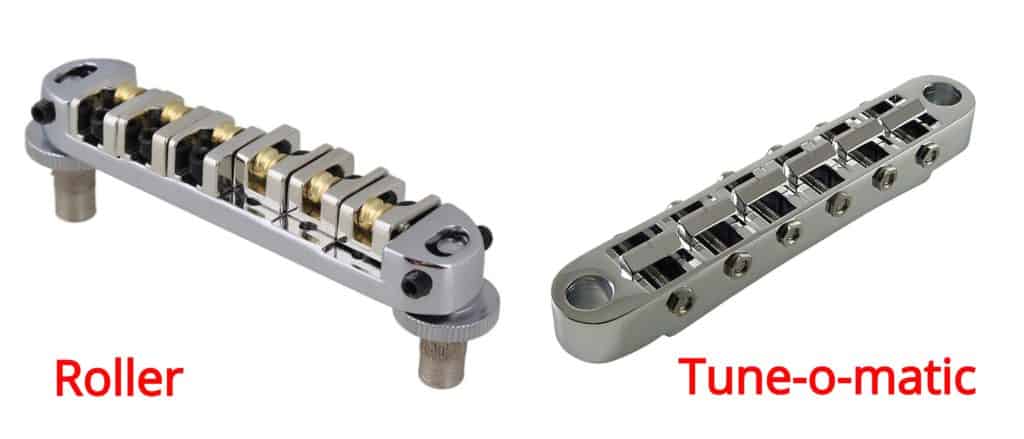
With the many options for guitar hardware. You may be interested to learn about roller bridges?
Are roller bridges worth it, and what are the potential benefits of replacing one with a conventional tune-o-matic bridge? So let’s dive in…
Roller bridges are worth it if you have a guitar with a Bigsby style tremolo system for better tuning stability and relieving the break angle of the strings. Roller bridges also provide less resting pressure and friction than a tune-o-matic bridge.
The earliest concepts of roller bridges take us back to the early 1960s with the further development of Bigsby vibrato tailpieces and the early version of the Maestro Vibrola. We could see these pieces on some of Gretsch and Gibson guitars.
The Purpose of a Roller Bridge
The idea behind these bridges was to have less friction and less pressure on the strings at the bridge while using a guitar vibrato system.
Things kept developing over the years, and eventually, we got improved versions by manufacturers like Schaller, which were intended to keep things in order.
Many of the Kahler and Floyd Rose tremolo systems also featured roller saddles that ensured a “safer” operation compared to the standard saddles.
Many of the standard saddles usually have a harsher angle at which strings “break” over the bridge. There are those narrow “V”-shaped furrows that hold the strings in one place.
The Function of a Roller Bridge
On roller bridges, we have individual rollers for each string. They allow smoother movement of the strings both back and forth and sideways.
For instance, using tremolo arms causes friction between the string and the saddle. There will be some movement involved as metal grinding on metal always causes damage over time.
This is especially the case with some of the Bigsby-style tremolos combined with classic tune-o-matic bridges – there will be a lot of movement involved and the strings will grind over the “V” cuts.
But on the roller bridges, the rolling saddles take the friction out of the equation. You are then left with a “safer” environment for your strings and smoother operation.
Of course, the same also goes for classic Fender tremolo bridges where pushing down on the tremolo arm causes unnecessary friction.
Pros & Cons
Pros
- Provide smoother operation with tremolo arm use
- They’re useful for Bigsby-style, Floyd Rose, and Kahler tremolo systems
- Enough room for sideways movements like bending and vibrato
- More tuning stability
Cons
- They usually don’t come with standard guitar models
- The setup might be a bit complicated, and it’s highly likely that you’ll need to consult a professional
Roller Bridge vs Tune-o-matic

The roller bridge is essentially a type of tune-o-matic. There are some significant differences that we should point out here.
The classic tune-o-matic bridge is one of the most often types of bridges on guitars. This is what you will find on a classic Les Paul or an SG.
They’re usually accompanied by a stop bar, and in some cases, strings can go through the body after the bridge. There are individual saddles for every string on every bridge, with each of them having the aforementioned “V”-shaped cuts or indents that hold the strings in place.
The main difference comes with the saddles. As we already mentioned, the roller bridge brings in the specialized rolling parts in the saddles. By putting your string over them, you get smoother string movement in both directions.
This means that when you’re tuning your guitar or using a tremolo arm, there will be way less friction compared to the classic tune-o-matic bridge.
At the same time, roller bridges provide more side movement as the string furrow in them is not as narrow and sharp as in tune-o-matic bridges, or in most of the other standard bridges.
It’s also worth mentioning is that the breaking angle of the strings is way more pronounced on tune-o-matic bridges. When the strings are going from the stop bar and over the bridge, the angle is usually pretty pronounced.
This puts more pressure and tension on them and will cause more damage to the strings, which could cause potential breaks. On roller bridges, this is less of a concern.
You’ll find different types of guitars that have roller bridges on them. First, we have guitars that usually come with tune-o-matic bridges that can easily fit roller bridges.
Then there are some guitars with complex tremolo systems, like Kahler or Floyd Rose, that also use their own types of roller bridges that are integrated into these systems.
Aside from more “breathing space” for the strings, some have also argued that they find the roller bridges more comfortable for the palm of their picking hand. This might differ from player to player, but the lack of sharp edges definitely helps bring more comfort.
Is a Roller Bridge Essential with a Bigsby?
Talking about Bigsby and Bigsby-style tremolo systems, you can find many different opinions about whether you really need a roller bridge in these kinds of settings.
While some prefer to use classic tune-o-matics in this case, we would argue that roller bridges are a better option.
Of course, everyone’s free to use what they feel more comfortable with, and classic bridges won’t make it impossible for you to use a Bigsby. However, there are some benefits of using a roller in this case.
The first and obvious thing is that there will be a lot of string movement with Bigsby tailpieces. And as we explained, more movement brings more friction, so the rolling saddles will be of great help here.
In case you don’t feel like using roller bridges for Bigsby tremolos, make sure to take care of everything and lubricate the nut, the saddles, and basically any other contact points. And be ready for more potential string breaks.
Another thing to consider is also the smoother angle at which the strings go over the rolling bridge. Combined with all the string movement and contact points, this is something that will definitely help you with tuning stability.
There are also some other alternatives for Bigsby tailpieces, like the rocking bar bridge. Although it doesn’t have rolling saddles, it definitely decreases friction and eases up the breaking angle of the strings, which definitely reduces risks of string break.
Common Questions
Do roller bridges increase tuning stability?
Tuning stability often depends on many different factors. Generally speaking, roller bridges do provide more consistency and stability in tuning. However, they are one of the factors in the whole equation that will help you here.
Do roller bridges reduce sustain and volume?
There have been many arguments about this topic, with people siding on both sides. Some would argue that they “soak up” the tone, but they’re generally designed to keep the sustain and not affect the tone in any negative way.
Do roller bridges fit most guitars?
Any guitar that has a standard tune-o-matic bridge, like the one you can see on a Les Paul, can support roller bridges. But other guitars with floating tremolos might also have a roller bridge integrated into the tremolo system. Some guitars might require drilling of additional holes and other modifications to fit the rolling bridge.
Are roller bridges inexpensive?
They are generally not that expensive. You can find some extremely cheap ones through large online retailers. However, it’s more recommended to go with some of the more famous and reliable brands built from quality materials. They can get up to $50 or more but are definitely worth it.
